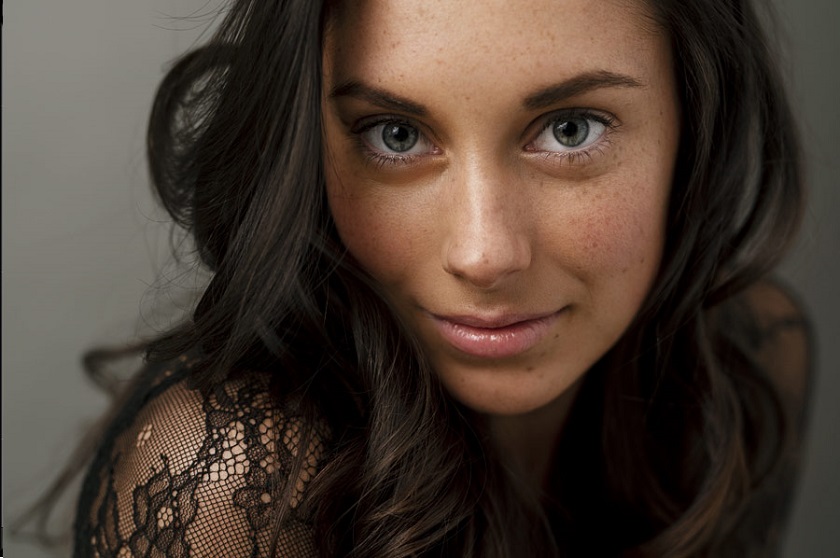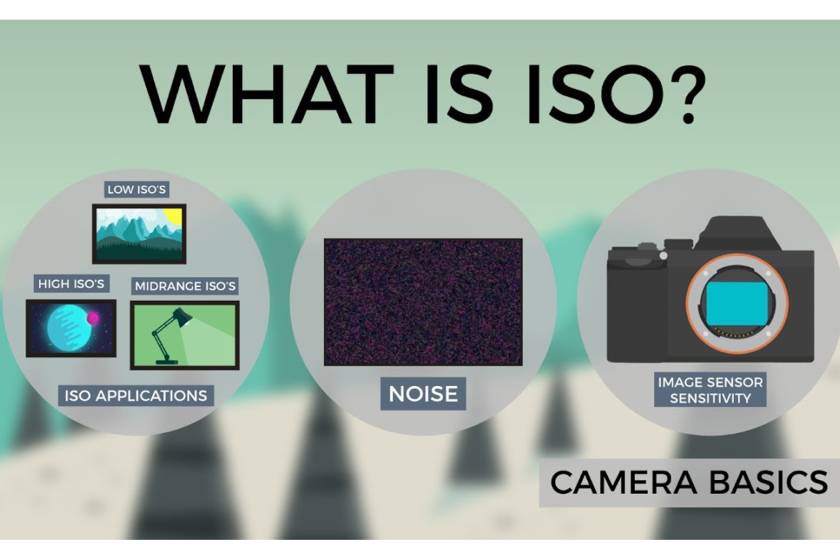Best Selling Products
Basic principles when working with color Theory
Nội dung
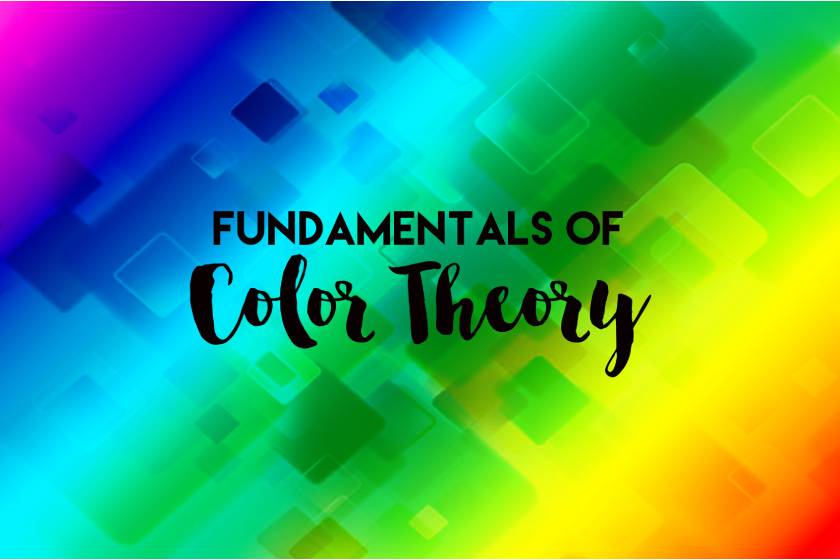
Color correction for images is one of the most important functions in Photoshop, so you need to have a good understanding of the basic principles when working with color to use Photoshop effectively.
 Color Theory
Color TheoryColor
If you want to learn how to manage color then you should first understand what it is:
Color: is an attribute of objects and light, it will originate in the eye or brain of the observer. In other words, color is an event occurring between three factors: the light source, the object, and the observer.
Light: is part of the electromagnetic spectrum, and the human eye is only sensitive to a small range of wavelengths near the middle of the spectrum. When radiation in this part of the spectrum sees rays of light hitting the eye, the brain senses light and color.
Most camera and film sensors are manufactured to respond to the same range of waves that the eye can see, but some of them can also react to ultraviolet and infrared radiation.
To make the best use of the expressive power of color, you need to understand some color science and its psychology.
Color wheel and color modes
All colors can be created by mixing the three primary colors.?
The basic metric of additive color system: RGB (Red, Green, Blue) is a blend of red, green, and blue light points in different proportions to produce any of the above colors. computer screen and television.
CMYK (Cyan, Magenta, Yellow & Key = Black) is the Subtractive color model, which explains the blending of paints, dyes, inks and natural colorants to create a full range of colors, each color produced. by subtracting (ie absorbing) some wavelengths of light and reflecting others.
Hence: choose RGB, the additive color system, for your on-screen image and CMYK, the Subtractive color model, for your prints (check with your print lab!).
CMYK cannot reproduce all bright colors like RGB, which is why it takes knowledge and experience to make sure your images look exactly the same on screen and when printed.
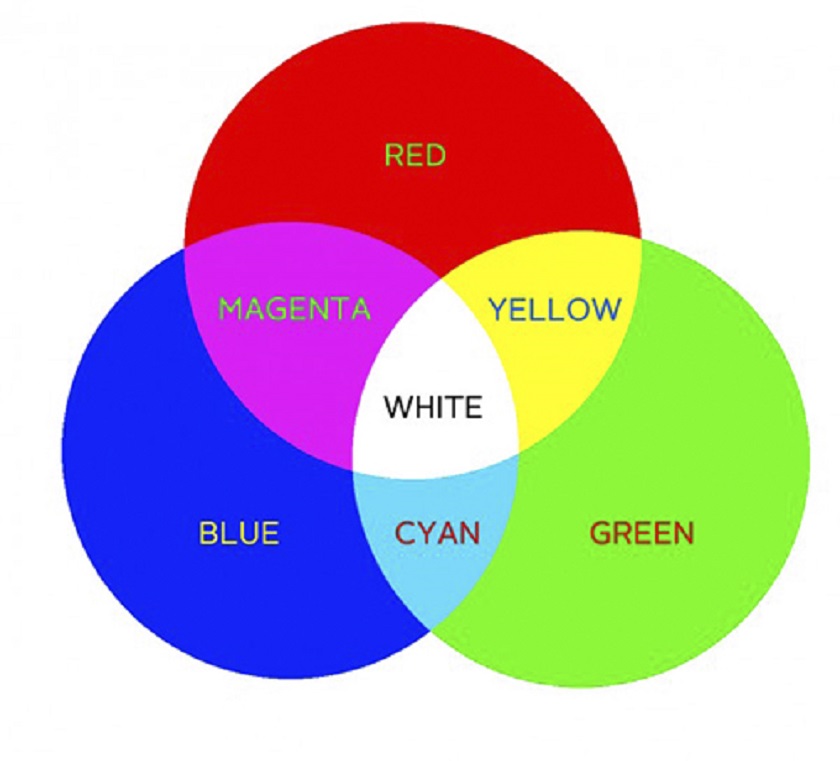 CMYK color
CMYK colorRelationship between Spectrum and Tricky trich
Why RGB and CMYK are always written in that order (not GRB or YCKM):
- The colors of the spectrum are usually listed in ascending frequency order: red, orange, yellow, green, blue, and purple - ROYGBV;
- The additive preliminary results divide this spectrum by almost one-third, corresponding to the colors red, green and blue. So ROYGBV leads to RGB;
- We write subtracting primes in the order they match them to their addition arguments (their opposites), so RGB leads to CMY (K = black).
You may find this helpful for memorizing complementary colors. For example, if you are working on a CMYK image with a blue color and need to compensate: just remember RGB / CMY, so Red adds Cyan, Green to Magenta and Blue blue to Yellow.
In other words, when you add Yellow, Blue is subtracted, and vice versa. The same applies to the rest of the primary elections.
See some more examples
When you need to quickly find the opposite or complementary color for the color you're using, sample your color sample (hold Option (ALT) when working with the Brush tool or use the Eyedropper tool) and go to the Color menu. Picker. Add or subtract 180 from the H number in the H (chroma), S (saturation), and B (brightness) values.
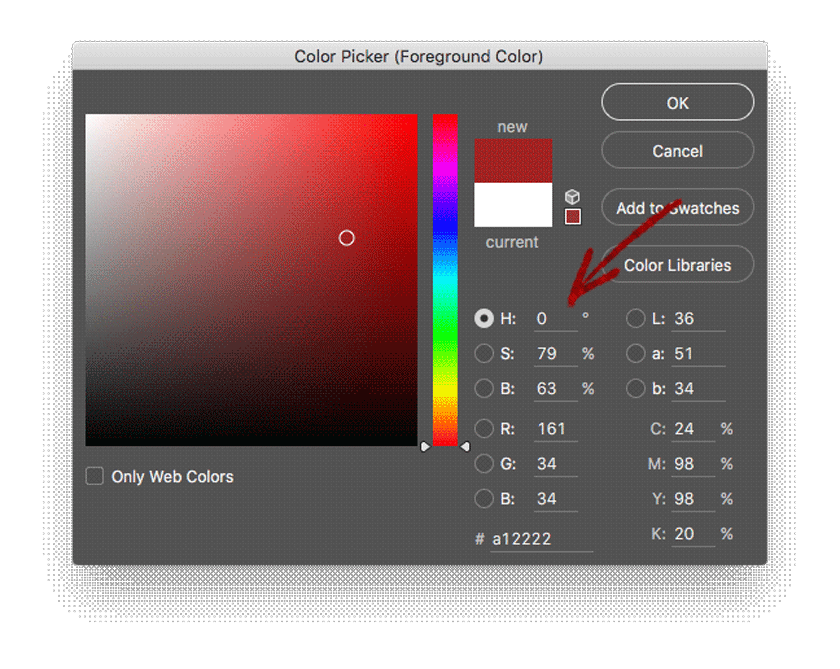 Brush tool
Brush toolObserver: human eye
The human eye has three types of color sensors (red, green, and blue, respectively) and that's what allows us to reproduce colors using just three pigments on paper or just three phosphors in the screen.
The retina is a complex layer of nerve cells that line the back of your eye. Nerve cells in the retina that respond to light are called photoreceptors, and come in two types: rod cells and cone cells (due to their shape).
- Rod-shaped cells provide low-light and color-blind vision.
- Cones cells respond to colors and tones, and operate in bright light.
According to Harvard neurologist Margaret Livingstone, the brain processes tonal information separately from color.
On top of that, our brains make us believe that local colors and tones are stable and unchanging. For example, if we look at a green car lit by an orange sunset or a garage fluorescent light, we still believe it is green. Our visual system constantly makes such inferences and it is almost impossible for our sane mind to override it.
Here are a few visual examples:
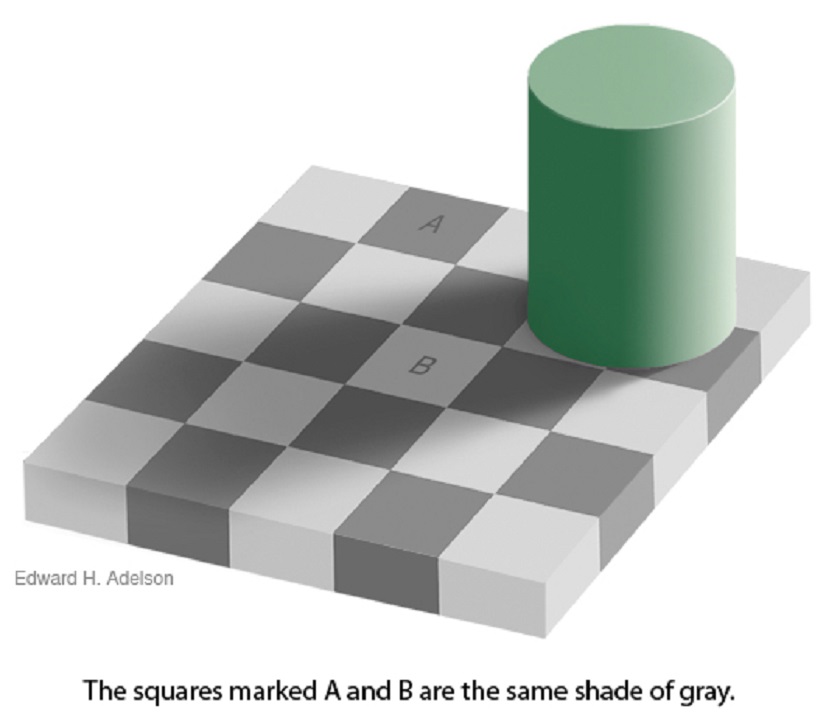 the Checker shadow illusion
the Checker shadow illusionIn the Checker shadow illusion published by Edward H. Adelson, Professor of Visual Science at MIT, the squares marked A and B have the same gray color, but they appear different. It happens because our visual system tries to locate balls and compensate them. And it all happens without our conscious control. ?
However, when squares A and B are isolated from their surroundings, the effect of the illusion will be dispelled.
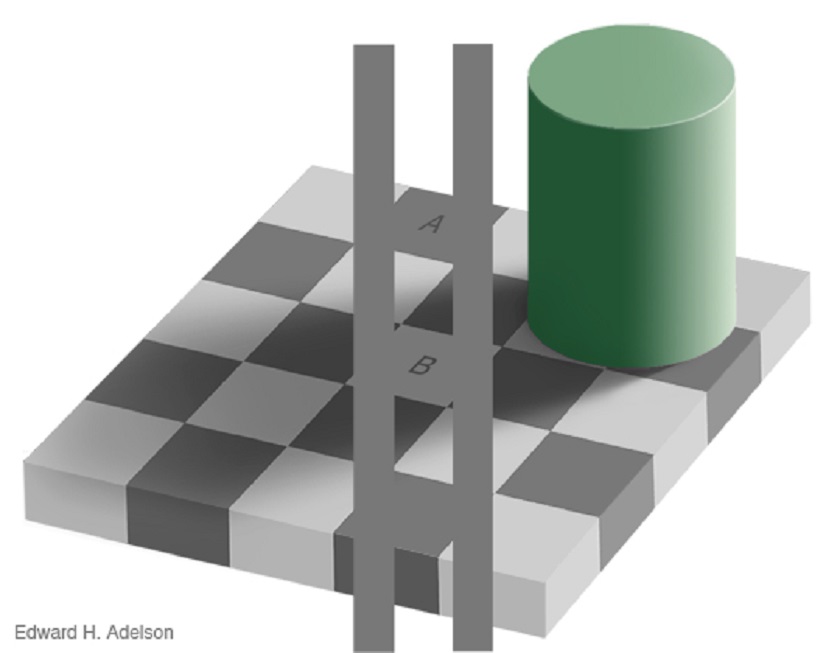 the effect of the illusion will be dispelled
the effect of the illusion will be dispelledIf you are still in doubt, you can download these images and compare the colors of squares A and B using the Eyedropper tool in Photoshop.
Here's what happens when we are deceived by our visual systems when we look at color:
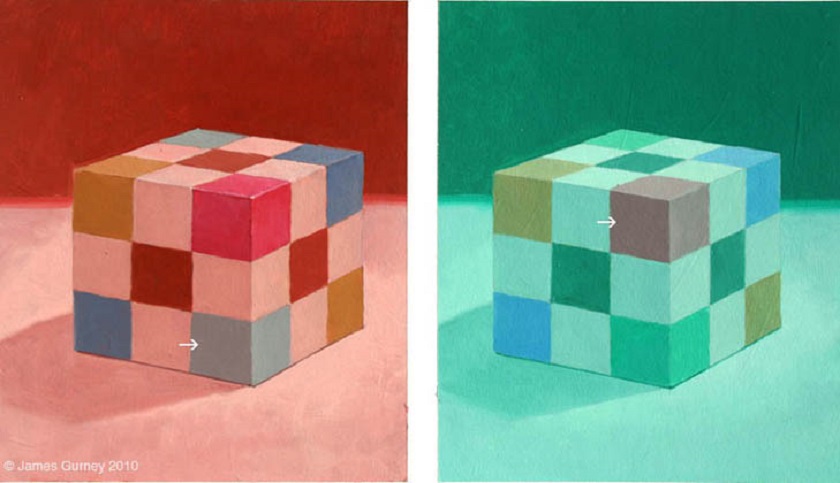 James Gurney's Cube Illusion
James Gurney's Cube IllusionThe same tricks our visual systems play with us when we look at James Gurney's Cube Illusion. The background of the picture makes us believe that squares A and B have different colors, when in fact they have the same neutral gray. That becomes apparent when we place both squares side by side:
 that squares A and B have different colors
that squares A and B have different colorsAs you can see, it's possible to turn off context cues and see true colors. To do that, we first need to be aware of the conjectures that are constantly occurring in our visual perception, and second, learn to mentally or physically isolate the colors. that we are trying to judge in a picture or reality.
Color characteristics
The color system divides all colors into three measurements: hue, value, and saturation.
Color: is the most intuitive of the three, it is what we usually name the colors of objects: a green car, a red apple.
Value: (sometimes called Brightness or Luminance) is a measure of how bright or dark a color or gray will remain if the color is removed.? Two different colors can have identical values.
Saturation: purity, vividness or intensity of color.
Color balance and color temperature
Precise colors in your photos come from a tight match between the color temperature of the light on your subject and the color balance of your film or digital sensor (i.e., in-camera White Balance. DSLR). In photography, color balance is a global adjustment of the intensity of the colors. The important goal of this adjustment is to render specific colors - especially neutral ones - so that they appear accurate or pleasing in the image.
Color temperature is a property of visible light that has important applications in lighting, photography, videography and other fields, and is denoted in absolute temperature unit, kelvin, symbolized K units A color temperature above 5,000K is called a cool color (bluish-white), while a lower color temperature (2,700–3,000K) is a warm color (yellow-white to red). Yes, somewhat confusing, at first: higher Kelvin temperatures cause colder colors and lower Kelvin temperatures cause lighter colors. Kelvin temperature makes colors warmer.
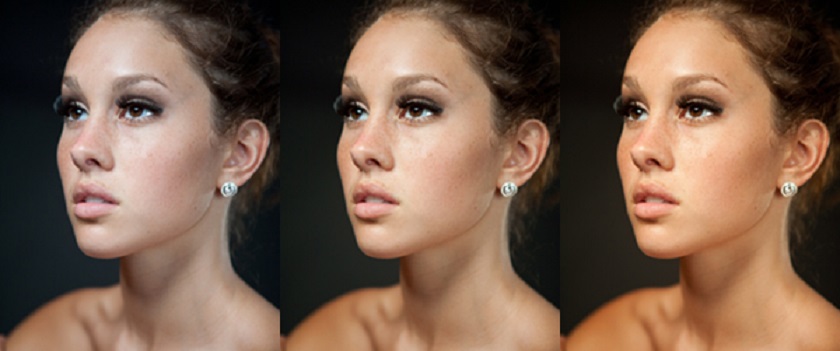 Color temperature
Color temperatureIf the White Balance setting on your camera is incorrect at the time of taking the photo, you will notice it with a slight or strong color signal (in most cases blue or yellow). Don't worry it is still possible to save your image, especially if you shoot in Raw format. The chances of ruining an image with an incorrect white balance setting are much higher when shooting in JPEG format. Simply have everything in camera as you shoot.
Then you should always shoot in Raw format!
See more Understanding the color composition of an image








































